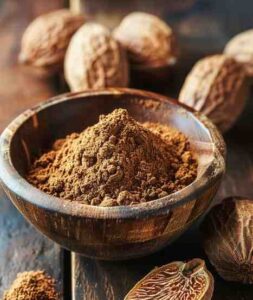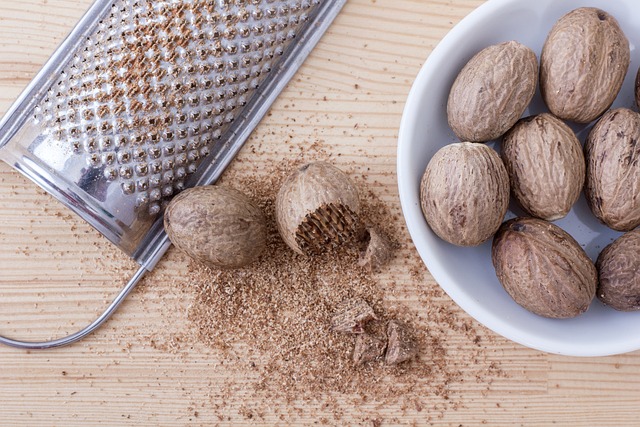Nutmeg, a spice that has captivated the world for centuries, comes from the Myristica fragrans tree. Native to the Banda Islands in Indonesia, it was once considered one of the most valuable commodities. These islands remained the exclusive producers of nutmeg for many years, making it a highly coveted spice.
The Origins and Historical Journey of Nutmeg
- Banda Islands: The indigenous people of these islands used nutmeg as a staple in their everyday lives. To outsiders, however, nutmeg represented immense wealth and power.
- European Discovery: During the Middle Ages, Arab traders brought nutmeg to Europe, where its culinary and medicinal uses made it a highly sought-after commodity.
As European nations began to vie for control over the Banda Islands, the competition became fierce. The Dutch East India Company monopolized the trade, going to extreme lengths, including the destruction of nutmeg trees that weren’t under their control. This conflict led to centuries of war and spice trade tensions, involving not only the Dutch but also the British and Portuguese.
Today, nutmeg cultivation has expanded to various tropical regions. Though Indonesia remains a top producer, other countries like Grenada also grow nutmeg.
Nutmeg in Ancient Medicine
For centuries, ancient civilizations used nutmeg for its medicinal properties, especially in treating various ailments.
- Chinese Medicine: Nutmeg was commonly used in traditional Chinese medicine to relieve stomach pains and cold symptoms.
- Ayurveda: In Indian Ayurvedic practices, nutmeg was believed to promote relaxation and improve circulation.
- Medieval Europe: During the Middle Ages, nutmeg gained a reputation as a cure-all. Wealthy individuals often carried nutmeg graters to add the spice to their drinks, using it as a quick remedy for digestive issues and headaches.
Nutmeg’s role as a medicinal spice continued to evolve, with many cultures holding it in high regard for its calming and healing properties.
Nutmeg and Mace: Understanding the Difference
Though both nutmeg and mace come from the Myristica fragrans tree, they differ significantly.
- Nutmeg: Derived from the seed, nutmeg has a warm, sweet, and slightly nutty flavor. It works well in both sweet and savory dishes.
- Mace: The red, lacy covering around the seed is mace. It has a more delicate, peppery taste, making it ideal for lighter dishes such as soups and pastries.
Despite their differences, nutmeg and mace are interchangeable in certain recipes. However, each spice brings its unique flavor profile to the dish, making them essential in different culinary applications.
Active Components of Nutmeg
Nutmeg’s distinctive flavor and medicinal qualities come from its active compounds, primarily myristicin and safrole.
- Myristicin: This compound gives nutmeg its signature aroma and flavor. In small amounts, myristicin enhances food, but consuming it in large quantities can affect the central nervous system, causing nausea, dizziness, and hallucinations.
- Safrole: Though it contributes to nutmeg’s flavor, safrole has been linked to potential carcinogenic effects. As a result, some countries have restricted its use in food products.
Dangers of Overusing Nutmeg
While nutmeg is widely cherished for its flavor, consuming it in large quantities can pose significant health risks.
- Toxicity: Overconsumption of nutmeg can lead to nutmeg poisoning, a serious condition that can cause symptoms like nausea, dizziness, and seizures. In some extreme cases, nutmeg poisoning can even be fatal.
- Hallucinogenic Effects: Myristicin, one of the active compounds in nutmeg, can cause hallucinations when consumed in large doses. Historically, some people have attempted to use nutmeg for its psychoactive effects, but the risks far outweigh any potential benefits.
Nutmeg should always be used in moderation, with careful attention paid to the quantity added to recipes. Two teaspoons of nutmeg can be enough to cause toxic effects, so it’s essential to avoid overuse.
Regulation of Nutmeg in Modern Times

Due to nutmeg’s potential for misuse, some countries have introduced regulations regarding its sale and use.
- Sale Limitations: To prevent abuse, certain regions restrict the amount of nutmeg that can be purchased. These regulations aim to ensure nutmeg’s safe consumption, focusing on culinary and medicinal use.
- Historical Context: During the spice trade era, the Dutch enforced strict controls over nutmeg to maintain their monopoly. However, modern regulations are more focused on public health and minimizing the risks of misuse.
Culinary Uses of Nutmeg Across the Globe
Nutmeg’s warm, aromatic flavor has made it a staple in global cuisines for centuries. Its versatility allows it to enhance both sweet and savory dishes, offering a balance of warmth and subtle spice.
Nutmeg in European Cuisine
In Europe, nutmeg has long been a beloved spice, often associated with holiday baking and comforting dishes.
- Baked Goods: Nutmeg shines in pies, cakes, and cookies. For instance, it plays a key role in traditional apple pie, balancing the sweetness of the fruit with its spicy undertones. Nutmeg is also essential in gingerbread cookies, complementing the sharpness of ginger with warmth and depth.
- Holiday Treats: Nutmeg features prominently in pumpkin pie during the autumn and winter months, combining with spices like cinnamon and cloves for a classic flavor.
- Mashed Potatoes and Creamed Spinach: Nutmeg’s subtle sweetness adds depth to creamy dishes like mashed potatoes and creamed spinach, enhancing their richness without overwhelming the flavors.
Nutmeg in Italian Cuisine
In Italy, nutmeg enhances savory dishes, adding complexity to sauces and fillings.
- Béchamel Sauce: Nutmeg elevates the creamy texture of béchamel sauce, commonly used in lasagna, gratins, and baked pasta. Just a pinch of nutmeg enhances the creaminess of the sauce while balancing the richness of the cheese.
- Ravioli Fillings: Nutmeg is often included in fillings for ravioli, particularly those made with spinach and ricotta. Its warm flavor complements the savory ingredients, creating a balanced dish.
Nutmeg in Indian and Moroccan Cuisine
In Indian and Moroccan cuisines, nutmeg is a crucial spice, often used in complex spice blends that define the region’s iconic dishes.
- Indian Cuisine: Nutmeg plays a key role in garam masala, a spice blend used in curries, stews, and sauces. Its sweet and warm notes balance the intensity of the other spices, making it essential for meat and vegetable dishes.
- Moroccan Cuisine: Nutmeg is a component of ras el hanout, a Moroccan spice blend used in tagines, couscous, and grilled meats. It adds depth to the savory flavors, contributing to the signature richness of Moroccan dishes.
Nutmeg in Beverages
Beyond its culinary uses, nutmeg adds a comforting warmth to beverages, especially during colder months.
- Eggnog: Nutmeg is a traditional ingredient in eggnog, a creamy, rich holiday drink. A sprinkle of nutmeg adds warmth and spice, enhancing the flavors of milk, cream, and rum.
- Mulled Wine and Spiced Cider: Nutmeg pairs perfectly with cinnamon and cloves in mulled wine and spiced cider, creating a warming drink often enjoyed during the winter.
- Chai Tea: In Indian chai tea, nutmeg works alongside cardamom, cloves, and cinnamon to deliver a full-bodied, spiced flavor that’s both comforting and invigorating.
Nutmeg’s ability to enhance beverages demonstrates its versatility beyond food. Whether in creamy drinks or spiced teas, it brings warmth and complexity that’s hard to replicate.

The Global Spread of Nutmeg: From Spice Wars to Culinary Staples
The global influence of nutmeg can be traced back to the Age of Exploration, when European colonizers spread it to new regions. Nutmeg’s history is intertwined with conquest, monopoly, and trade wars, but its legacy endures in kitchens worldwide.
European Colonization and the Spread of Nutmeg
During the 16th and 17th centuries, European colonizers, including the Portuguese, Dutch, and British, fought fiercely over control of nutmeg-producing regions. The Dutch East India Company maintained a monopoly on the spice for many years, leading to extreme measures such as destroying nutmeg trees outside their territories. This allowed them to control the price and trade of nutmeg.
- British Involvement: Over time, the British entered the fray, contributing to the intense rivalry. Nutmeg became a valuable commodity in global trade, leading to significant profits for those who controlled its production.
Eventually, nutmeg cultivation spread beyond the Banda Islands to other tropical regions. Grenada, known as the “Island of Spice,” became a major producer. Today, Grenada and Indonesia remain among the top exporters of nutmeg, and the spice has become a staple in kitchens around the world.
Nutmeg’s Role in Caribbean Cuisine
Nutmeg’s influence reached the Caribbean, where it became a key ingredient in regional dishes.
- Grenadian Cuisine: In Grenada, nutmeg is widely used in desserts, drinks, and savory dishes. The island’s cuisine celebrates the spice, often pairing it with cloves, cinnamon, and allspice in dishes like spiced rum punch and nutmeg-flavored desserts.
- Jamaican Cuisine: Nutmeg plays a role in Jamaican dishes, especially in desserts like rum cake and spiced buns. The spice adds warmth and depth to these sweet treats, making it a beloved ingredient during festive occasions.
The spread of nutmeg to the Caribbean exemplifies how this spice became embedded in diverse cultures worldwide, influencing both sweet and savory cooking.
Famous Recipes Featuring Nutmeg
Nutmeg’s versatility shines in a variety of famous dishes, both sweet and savory. Its ability to complement other ingredients while adding warmth and complexity makes it a staple in many global cuisines.
Sweet Dishes
- Apple Pie: Nutmeg balances the sweetness of apples with its spicy undertones, creating a comforting dessert.
- Pumpkin Pie: Essential to the classic autumn dessert, nutmeg works alongside cinnamon and cloves to enhance the earthy flavor of pumpkin.
- Gingerbread Cookies: Nutmeg adds depth to the molasses flavor, balancing the sharpness of ginger with a hint of warmth.
Savory Dishes
- Béchamel Sauce: A small amount of nutmeg brings out the creamy richness in béchamel sauce, perfect for lasagna and gratins.
- Creamed Spinach: Nutmeg elevates creamed spinach, adding subtle warmth that complements the earthy flavor of spinach.
- Mashed Potatoes: Nutmeg gives mashed potatoes a layer of complexity, balancing the creaminess with a touch of spice.
Beverages
- Eggnog: Nutmeg’s signature warmth makes it an essential component of this festive holiday drink.
- Chai Tea: Nutmeg enhances the spiced blend of chai, adding depth to its aromatic flavor.
- Mulled Wine: Nutmeg’s ability to harmonize with other spices like cinnamon and cloves makes it ideal for mulled wine.
Nutmeg in Modern Gastronomy and Health Research
In recent years, nutmeg has continued to inspire chefs and researchers alike. Its unique flavor and active compounds are the subject of both culinary innovation and scientific study.
Modern Culinary Uses
Chefs around the world are finding new ways to incorporate nutmeg into both traditional and contemporary dishes. In molecular gastronomy, nutmeg is often used in unexpected combinations, pairing it with savory ingredients like meats or creamy sauces to create complex flavor profiles.
- Savory-Sweet Pairings: Chefs use nutmeg to balance savory dishes with sweet notes, such as in braised meats or vanilla-nutmeg sauces.
- Spiced Desserts: Modern pastry chefs experiment with nutmeg in desserts that combine multiple layers of flavor, using the spice to enhance both sweetness and warmth.
Health Benefits and Research
Nutmeg’s active compounds, including myristicin and eugenol, have attracted attention from health researchers. Studies have begun to explore the potential health benefits of nutmeg, focusing on its anti-inflammatory and antioxidant properties.
- Anti-inflammatory Effects: Myristicin has been studied for its potential to reduce inflammation, offering potential benefits for those with conditions like arthritis.
- Antioxidant Properties: Nutmeg’s antioxidants may help protect cells from oxidative stress, reducing the risk of chronic diseases.
However, while these benefits are promising, it’s important to use nutmeg in moderation to avoid potential toxicity, particularly related to its psychoactive effects.

